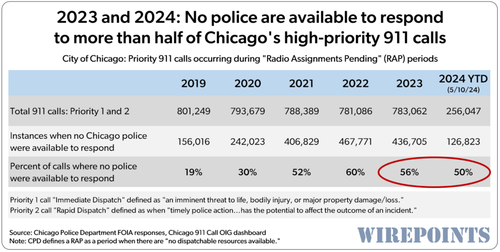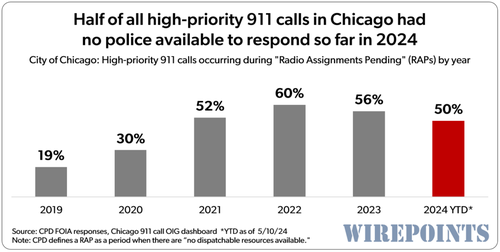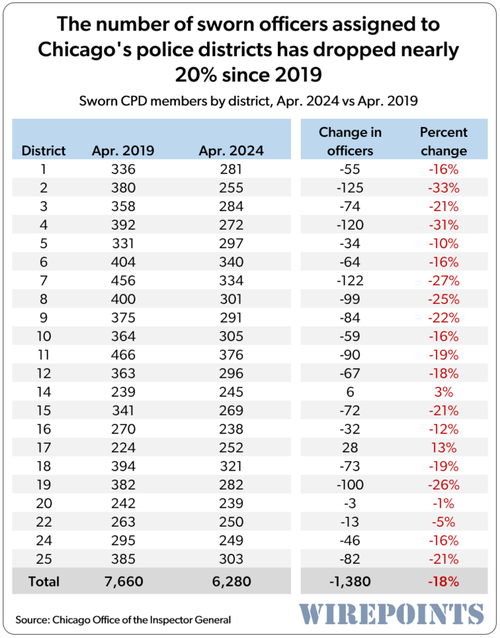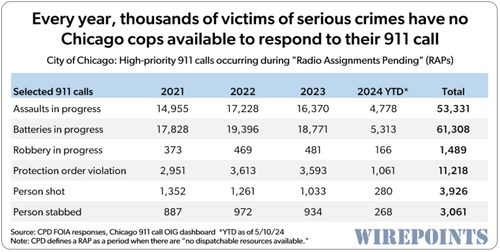
By Ted Dabrowski, John Klingner and Nick Binotti of Wirepoints
In Chicago in 2023, more than 1,800 calls were made to 911 of a person being shot. Only about 800 – fewer than half – were responded to immediately by police officers. The other 1,000 callers were victims of 911 backlogs, where no police were available at the time of the call. Those victims had to wait half an hour, an hour, or even several hours for the 911 call backlog to end and for police to finally arrive.
It was the same for the 32,000 911 calls of an assault in progress, where police were only immediately available for 50% of those calls. And it was the same for 54% of the city’s 911 calls of 35,000 batteries in progress.
In all, there were 783,000 high-priority 911 calls in 2023. For 437,000 of those calls, or 56%, long periods of backlogs meant there were no police immediately available. Wirepoints obtained the 911 call and response data directly from the Chicago Police Department via FOIA.
The fact that it’s essentially a 50/50 chance as to whether officers show up promptly for a violent crime should be horrifying to the residents of Chicago. In part, sources tell us it’s an operational and logistics problem. It’s also a staffing problem – the number of beat cops in the city are down nearly 20% compared to 2019. Police are also forced to increasingly focus on consent decree compliance and bureaucratic paperwork, insiders tell us, which keeps officers off the street. But most of all it’s a problem of city leadership that’s made Chicago’s policing and criminal justice system dysfunctional. With violent crimes at its highest point since 2019, a lack of police response is but one of the many problems keeping Chicagoans unsafe.
This year, the bad trend continues. So far in 2024, 127,000 of the 256,000 high-priority 911 calls made in Chicago had no police available to immediately respond. That’s a “no police available” rate of 50%.
No one available
The ability of police officers’ to respond to urgent “Priority Level 1” and “Priority Level 2” 911 calls has gotten worse since 2019.
High-priority calls, which make up 60% of all 911 calls made, aren’t for routine dispatches like noise complaints or theft reports. A Priority Level 1 call includes incidents that require “immediate dispatch for life-threatening emergencies.” And Priority Level 2 calls require “rapid dispatch for situations where timely public safety action has the potential to affect the outcome of an incident.”
Back in 2019, only 19% of calls had no officers available to immediately respond. That was 156,000 out of more than 800,000 high-priority 911 calls. That non-response rate grew higher each year thereafter, hitting a high of 60% in 2022. That increase coincided with the city’s soft-on-crime response to both the George Floyd event and the pandemic.
Through May 10th of this year, 50% of high-priority 911 calls had no immediate response from police – an improvement over previous years but still far above 2019’s rate. Based on the experience of previous years, 2024’s numbers will most likely grow worse as the city’s criminal activity rises during the summer.
A coin-flip
A look at the full-year 2023 numbers show that regardless of the crime, it’s basically a 50/50 shot if there are going to be police available to respond to a high priority 911 call. As mentioned above, calls reporting a person shot only had an immediate response 57% of the time last year. The city’s 8,200 calls reporting a robbery had only a 55% immediate response rate. Stabbings, a 52% rate. The more than 86,000 instances of domestic disturbances, a 54% rate.
And now with violent crime in Chicago at a six-year high in 2024, hundreds of new shooting, stabbing, robbery, battery and other violent crime victims will be left waiting for help every week. Here are just a few of the high-priority calls police couldn’t immediately respond to this year through May 10:
- 4,778 – assaults in progress
- 5,313 – batteries in progress
- 1,489 – robbery in progress
- 4,799 – person with a gun
- 1,724 – person with a knife
- 1,781 – shots fired
- 280 – person shot
- 268 – person stabbed
Staffing
Lower staffing levels at CPD will likely get much of the blame for the worsening 911 response rate. The number of sworn police officers today, at 11,700, is down by about 1,700 since the beginning of 2019. As a result, today there are nearly 1,400 fewer sworn officers assigned to the city’s patrol districts compared to 2019. That’s about 20 percent fewer police available to respond to calls.
A good example
Back in May, a Wicker Park woman left her door open after letting her dog out. Soon after, two men wearing masks entered her home. “I saw two men wearing masks standing inside my house. I screamed – ‘I am calling the police’ and they bolted.” The woman called 911. They said help was on the way and instructed her to wait outside.
The woman waited. And waited. Help didn’t arrive. Six calls to 911 later, she finally got hold of a supervisor. He explained there were no units to send. He then recommended the woman call her alderman to encourage him to hire more police. She was also asked if she “had a weapon or considered getting one.”
Police finally arrived four hours later.
Read more from Wirepoints:
- ‘Justice-impacted individuals’: More of the same as Chicago’s violent crimes continue their six-year high
- Up to $410 million extra being spent on children of illegal immigrants at Chicago Public Schools
- A disappointing first year for Chicago Mayor Brandon Johnson
Appendix
By Ted Dabrowski, John Klingner and Nick Binotti of Wirepoints
In Chicago in 2023, more than 1,800 calls were made to 911 of a person being shot. Only about 800 – fewer than half – were responded to immediately by police officers. The other 1,000 callers were victims of 911 backlogs, where no police were available at the time of the call. Those victims had to wait half an hour, an hour, or even several hours for the 911 call backlog to end and for police to finally arrive.
It was the same for the 32,000 911 calls of an assault in progress, where police were only immediately available for 50% of those calls. And it was the same for 54% of the city’s 911 calls of 35,000 batteries in progress.
In all, there were 783,000 high-priority 911 calls in 2023. For 437,000 of those calls, or 56%, long periods of backlogs meant there were no police immediately available. Wirepoints obtained the 911 call and response data directly from the Chicago Police Department via FOIA.
The fact that it’s essentially a 50/50 chance as to whether officers show up promptly for a violent crime should be horrifying to the residents of Chicago. In part, sources tell us it’s an operational and logistics problem. It’s also a staffing problem – the number of beat cops in the city are down nearly 20% compared to 2019. Police are also forced to increasingly focus on consent decree compliance and bureaucratic paperwork, insiders tell us, which keeps officers off the street. But most of all it’s a problem of city leadership that’s made Chicago’s policing and criminal justice system dysfunctional. With violent crimes at its highest point since 2019, a lack of police response is but one of the many problems keeping Chicagoans unsafe.
This year, the bad trend continues. So far in 2024, 127,000 of the 256,000 high-priority 911 calls made in Chicago had no police available to immediately respond. That’s a “no police available” rate of 50%.
No one available
The ability of police officers’ to respond to urgent “Priority Level 1” and “Priority Level 2” 911 calls has gotten worse since 2019.
High-priority calls, which make up 60% of all 911 calls made, aren’t for routine dispatches like noise complaints or theft reports. A Priority Level 1 call includes incidents that require “immediate dispatch for life-threatening emergencies.” And Priority Level 2 calls require “rapid dispatch for situations where timely public safety action has the potential to affect the outcome of an incident.”
Back in 2019, only 19% of calls had no officers available to immediately respond. That was 156,000 out of more than 800,000 high-priority 911 calls. That non-response rate grew higher each year thereafter, hitting a high of 60% in 2022. That increase coincided with the city’s soft-on-crime response to both the George Floyd event and the pandemic.
Through May 10th of this year, 50% of high-priority 911 calls had no immediate response from police – an improvement over previous years but still far above 2019’s rate. Based on the experience of previous years, 2024’s numbers will most likely grow worse as the city’s criminal activity rises during the summer.
A coin-flip
A look at the full-year 2023 numbers show that regardless of the crime, it’s basically a 50/50 shot if there are going to be police available to respond to a high priority 911 call. As mentioned above, calls reporting a person shot only had an immediate response 57% of the time last year. The city’s 8,200 calls reporting a robbery had only a 55% immediate response rate. Stabbings, a 52% rate. The more than 86,000 instances of domestic disturbances, a 54% rate.
And now with violent crime in Chicago at a six-year high in 2024, hundreds of new shooting, stabbing, robbery, battery and other violent crime victims will be left waiting for help every week. Here are just a few of the high-priority calls police couldn’t immediately respond to this year through May 10:
- 4,778 – assaults in progress
- 5,313 – batteries in progress
- 1,489 – robbery in progress
- 4,799 – person with a gun
- 1,724 – person with a knife
- 1,781 – shots fired
- 280 – person shot
- 268 – person stabbed
Staffing
Lower staffing levels at CPD will likely get much of the blame for the worsening 911 response rate. The number of sworn police officers today, at 11,700, is down by about 1,700 since the beginning of 2019. As a result, today there are nearly 1,400 fewer sworn officers assigned to the city’s patrol districts compared to 2019. That’s about 20 percent fewer police available to respond to calls.
A good example
Back in May, a Wicker Park woman left her door open after letting her dog out. Soon after, two men wearing masks entered her home. “I saw two men wearing masks standing inside my house. I screamed – ‘I am calling the police’ and they bolted.” The woman called 911. They said help was on the way and instructed her to wait outside.
The woman waited. And waited. Help didn’t arrive. Six calls to 911 later, she finally got hold of a supervisor. He explained there were no units to send. He then recommended the woman call her alderman to encourage him to hire more police. She was also asked if she “had a weapon or considered getting one.”
Police finally arrived four hours later.
Read more from Wirepoints:
Appendix
Loading…









